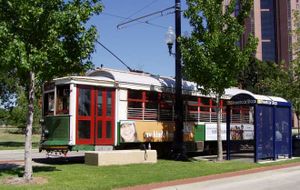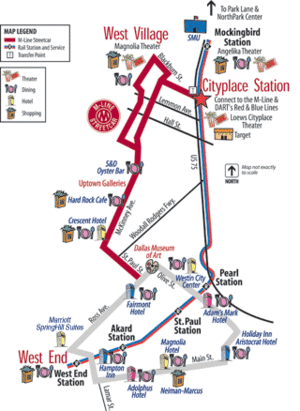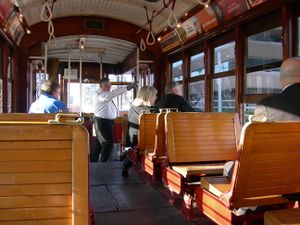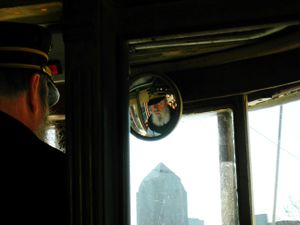McKinney Avenue Transit Authority
The McKinney Avenue Transit Authority (MATA), a non-profit organization, operates the M-line Streetcar line in Dallas, Texas (USA). The offices and car barn are located at 3153 Oak Grove, Dallas, TX 75204. It is a good example of a heritage streetcar running historic cars. The main stretch of the M-line runs down McKinney Avenue, through the LoMac community in Uptown.
The M-line Streetcar is free to the public, thanks to a joint operating subsidy received from Dallas Area Rapid Transit (DART) and the Uptown Improvement District. DART designates the streetcar's route as 825 at transit stops.
The M-line Streetcar connects with the DART light rail station at Cityplace Station on the Red and Blue lines. The downtown end of the line currently terminates at the corner of Ross and St. Paul near the Dallas Museum of Art, but there are plans to extend the M-line further into downtown.
Contents
History
Metropolitan Dallas had numerous streetcar lines from the late 1800s through 1930s. The last streetcar ran in Dallas during the mid-50's. Numerous maps of the old trolley routes are available online. [3]
During the 80's, there was a movement to restore streetcar service in Dallas's Uptown neighborhood after some of the original rails were uncovered on McKinney Avenue. New rails were first laid in September of 1988 near Hall Street. The initial infrastructure would be in place in the summer of 1989. On July 22, 1989 Dallas saw a return of the streetcar as Car 122 broke a celebratory banner.
In 1995, the agency had to fix subsidence in the street causing a dip in the tracks on Cole Avenue between Hall and Bowen Streets. About 200 feet of track was replaced.
By the late 1990s, it became apparent that the 110 year old brick pavement on McKinney Avenue could no longer support modern day car, truck and bus traffic. Repairs began in July 1999 and were completed in December 2000. The street was repaved with concrete brick and most of the old brick was saved for sidewalks and other amenities. Work was done on one lane of the street at a time. Many times the streetcars were rerouted, sometimes with a shoofly. For several months the north loop was inaccessible due to utility work at Allen and McKinney.
The first expansion of the system came at the turn of the century. Both DART and MATA desired the streetcar to meet up with DART's Cityplace subway station a few blocks from the route. The first new track for the Cityplace extension was laid on Cole Avenue south of Blackburn in June of 2001. In the summer of 2002 while the tracks were being laid, construction crews unearthed history as old center-of-the-street rail from Dallas Railway and Terminal tracks were discovered. On April 13, 2002, the extension was opened for the public. It is now possible to ride the DART LRT system and get off at Cityplace and immediately board the streetcar to Uptown.
Expansion
The City of Dallas and MATA have expressed a desire for further expansion of the current streetcar system. The current southern terminus ends in Downtown Dallas at Saint Paul Street and Ross Avenue. The plan is for a line to split off from the current line at McKinney and Olive Streets and travel down Olive to the light rail transit mall downtown near Pearl Station.[1] The agency will also have a new car barn built at the northwest corner of Olive and San Jacinto streets.
The federal government has given MATA 3.5 million for their mile expansion into downtown's Arts District. The total cost of the expansion is approximately 6.8 million dollars.
Part of the money needed for the expansion was put to voters in the form of a bond. On November 7, 2006, the voters of Dallas approved Proposition One, which asked voters if they would like to approve "The Issuance of $390,420,000 general obligation bonds for street and transportation improvements." The bond was approved 87.4% to 12.6%.
With the bond's passage, construction on the expansion should begin in the fall of 2007. [2]
Historic stock
Currently in service
- 122 - Crescent Rose
122 was built to a standard American design by the J.G. Brill and Company of Philadelphia in 1909 for export to Porto, Portugal. Rosie is similar to early streetcars that once operated in Dallas. 122 was retired from service in Porto in 1978. 122 only needed minor work to bring it into service on MATA's opening day. However, in the late 1990's 122 received a more extensive restoration. 122 also had motor problems which kept it in the barn during the early 2000's. These problems have been solved and 122 is in daily service.
- 143 - Winnie
Built as a single-ended PCC (President's Conference Car) streetcar by St. Louis Car Company in 1945 for (Washington) DC Transit. Operated by DC Transit as car 1506 until abandonment of that system in February 1962. Bought by Fort Worth's Marvin and Obediah Leonard for their proposed rail shuttle line from their vast parking lot to their downtown department store's basement station via a 1,400-foot subway. Rebuilt as a double-ended car and given a more "modernized" appearance in Fort Worth — stainless steel siding and blue roof trim. This modification did not completely conceal its standard PCC design heritage. Old 1506 was renumbered as M&O #4. No. 4 served as a Tandy Center Subway car until the line was abandoned on August 30, 2002. Despite modifications to soften the car's lines, it retained a distinctive shape reminiscent of a Winnebago -- hence the nickname.
Winnie has had air conditioning and other electrical problems which have kept it sidelined for most of 2006. The shop continues to work in the car.
- 186 - The Green Dragon
186 was built by the St. Louis Car Co. for Dallas Consolidated Electric Street Railway in 1913. The car served for 43 years in Dallas before being retired in 1956 when the streetcar system was abandoned. 186 was stripped of its running gear and electrical wiring and sold to a private individual who used it for a hay barn in far North Dallas. Ed Landrum, one of MATA's founders, acquired the car in 1979 and cosmetically restored it. The Green Dragon was originally displayed in the Texas Sports Hall of Fame in Grand Prairie, Texas. When the museum closed, Ed removed 186 and donated it to MATA, which restored the Green Dragon to running order in 1989.
- 369 - Matilda
369 was built in 1925 by James Moore, Ltd. for the Melbourne & Metropolitan Tramway Board in Melbourne, Australia. The car was in continuous service in Melbourne for six decades before being purchased by MATA in 1986. Matilda arrived in Portland, Oregon by ship and was then trucked to Dallas. Acquired in running order, Matilda only required cosmetic modifications to give her a more North American appearance.
- 636 - Petunia
Car 636 was part of an order for 25 streetcars for the Dallas Railway Co. from the J. G. Brill Co. Petunia, a "Birney Safety Car," (or Birney, for short) is named after its designer, Charles O. Birney of the Stone & Webster Co. The design incorporated numerous operational and safety improvements over earlier streetcars that permitted one man operation and thereby allowed street railway companies to reduce their expenses. Birneys were known for their bouncy riding qualities and were never very popular with the Dallas riding public. Nevertheless, 636 ran in Dallas until 1947 when it was replaced by more modern equipment. MATA's Ed and John Landrum, Frank Schultz and Dean Smith designed and built 636's current 8-foot-long truck using parts from the extra Melbourne trucks purchased along with Car 369. MATA later added shock absorbers to smooth out the Birney's characteristic bouncy ride.
- No Number - Miss Daisy
Built by the Fairmont Company of Fairmont, Minnesota around the turn of the 20th Century. Cars of this type were widely used by railways all over the world for track inspection. Volunteer Richard Fowler donated Miss Daisy to MATA in complete, but not operable condition. Used with a welder trailer and a rail grinder trailer, Miss Daisy enables MATA personnel perform minor rail repairs.
Cars being restored, rebuilt or modified
- 332 - The Morning Star
332 is one of four box motors built in the Northern Texas Traction interurban railway shops in 1912. When NTT ceased operations in 1934, a farmer near Granbury, Texas (southwest of Fort Worth) bought 332 and used it for grain storage. John Landrum, MATA's Chief Operating Officer, purchased the car in 1986. The Morning Star will primarily be used as a party or charter car, but due to its flexible seating arrangement, could also be used in regular transit service.
- 754
754, a 19-ton, 48-foot, 54-seat streetcar was built in 1926 by American Car Company for Dallas Railway and Terminal Co. It was originally a Peter Witt center entrance car. The DR&T later removed 754's center doors when the company rebuilt each of its Peter Witts for one-man operation. The 754 was on the active DR&T roster until the end of operations in January 1956. Shortly after system abandonment, Ben Carpenter (son of the president of Dallas Railway and Terminal Company from 1927 to 1935) moved 754 to his family's Hackberry Creek Ranch in Irving, Texas, and placed it on concrete blocks. 754 spent its retirement years there serving as a playhouse for the Carpenter children and grandchildren. The family built a miniature town around the car body. When all of his children and grandchildren had grown up, Mr. Carpenter decided it was time to donate the trolley to MATA.
754 is currently at Edwards Rail Car Company to be restored.
Cars awaiting restoration
- 183 and 189
183 and 189 were built for Dallas Railways in 1913 by St. Louis Car Company. They are typical Stone & Webster designed streetcars, sisters to the operating 186. In 1991 John Landrum discovered the two cars built into a home in Lewisville, a few miles north Dallas. Since the building was about to be demolished, on January 10, 1994, MATA volunteers went to Lewisville and tore the warehouse down to expose and recover the cars.
- 323
323 is a 13-window Stone & Webster "turtleback" type street car built in 1915 as part of an order for 26 such cars for the Northern Texas Traction Company of Ft. Worth. 323 is the only known example of the Stone and Webster "stretch" streetcar still in existence in the world today.
- 4613 and 4614 (Ex-Toronto PCCs)
At one time With a fleet of 745 cars, Toronto was once the largest operator of PCCs in the world. Eventually only nineteen Toronto PCCs remained and these were used on only one route — the Harbourfront Line. The Toronto PCC era ended on December 8, 1995, when the last such cars ran on that line. These PCCs were built in 1951 and extensively rebuilt by the TTC in the early 1990s, making them the equivalent of almost brand-new streetcars. Not wanting to see these last PCCs scrapped, John Landrum helped Tom Twigge, a Toronto Transit Commission employee, formed a coalition of trolley museums to save the remaining cars from being scrapped and new find homes for them. MATA bought these two cars.




